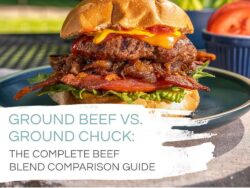
New York Strip vs. Ribeye: The Ultimate Steak Showdown
Oct 9, 2023 | Cooking with Beef, Natural Angus Beef
In the realm of culinary delights, few dishes hold the same timeless appeal as a perfectly cooked steak. From the sizzling sounds of the grill or pan, or the bubbling of the sous vide, to the mouthwatering aroma wafting through the air, the alluring promise of an indulgent feast makes steak a staple on menus worldwide. One can rarely order or purchase a generic “steak,” as different cuts have unique traits and strengths.
Among the variety of cuts available, two steaks stand out as champions of flavor and tenderness—the New York strip and the ribeye. Our taste buds win this bout regardless, but to decide which cut is right for you on a given night, let’s savor the nuances of these two iconic cuts of beef.
Pro tip: whichever you choose, we recommend USDA Prime or Choice Natural Angus beef for added marbling and flavor.
Understanding the Cuts: The Anatomy of Excellence
What is a New York Strip Steak?
The New York strip, or a strip loin steak, hails from the short loin, which is home to some of the most tender and popular cuts of beef. This cut, specifically, rose to prominence in the 19th century at Delmonico’s Restaurant in New York City, an influential spot that is known as the first fine dining establishment in the country. The strip loin steak gained popularity with Delmonico’s patrons and quickly became associated with the city’s namesake.
A New York strip boasts a lean profile with generous marbling, ensuring a harmonious balance of tenderness and flavor.
What is a Ribeye Steak?
The ribeye, on the other hand, hails from the rib primal and is known for its rich marbling and buttery flavor. Often referred to as the “king of steaks,” this cut is renowned by steak lovers and chefs alike for its tender, juicy texture and its versatility.
We would be remiss if we didn’t mention price point as part of our comparison between the New York strip and ribeye. Influential factors such as how the cattle are raised, the aging process, and current market trends all go toward gauging the worth and determining the cost of these cuts. The New York strip’s balance of flavor and lean meat justifies its slightly more budget-friendly status, while the ribeye offers exceptional tenderness and marbling, contributing to its more coveted status and thus higher price tag.
Pro tip: Bone-in ribeye can bring even more flavor and tenderness, so it’s common to see them priced a few dollars higher per pound than boneless.
Sizzle Showdown: Cooking Techniques
As with all cuts, the way a steak is prepared can elevate its flavors to new heights. Both the New York strip and the ribeye can reach perfection with different cooking techniques. Below we’ll cover tips for cooking each cut perfectly with the most common methods, but we’ve also written simplified instructions for cooking beef via sous vide.
With all techniques, as with all cuts of steak, it is best to allow a steak to rest for 5-10 minutes after cooking to allow its juices to redistribute for maximal flavor. Further, all types of natural Angus beef taste delicious with either minimal seasoning or with your choice of marinade.
View our variety of natural Angus beef recipes.
How to Cook New York Strip Steak Perfectly
Cooking New York Strip on a Stove
The New York strip excels in a hot cast-iron pan (or on the grill), forming a tantalizing crust while maintaining its tender core. Searing the steak helps to lock in its delicious juices.
Learn more about how to pan-fry New York strip.
Cooking New York Strip on a Grill
Place your one-inch-thick New York strip steak onto a grill preheated to a high heat, approximately 450°F-650°F. Cook on each side for two to three minutes or until steak reaches an internal temperature of 130°F for medium doneness (steak will continue to cook as it rests, raising the temperature to 135°F – 145°F).
Learn more about how to cook New York strip over charcoal.
How to Cook Ribeye Steak Perfectly
Cooking Ribeye on a Stove
Ribeye, with its abundant marbling, thrives under high-heat cooking methods like searing. Add the steak to a skillet over medium heat with olive oil, butter, or a combination of both. Be sure to sear each side of the ribeye to achieve an exceptional crust as it reaches your target internal temperature of 135°F (aka medium-rare), then allow to rest for at least three minutes.
Learn more about how to pan-fry ribeye.
Cooking Ribeye on a Grill
Ribeye’s generous marbling would lead you to think low-and-slow grilling is the way to go. But we recommend hot and fast (and not just because you can’t wait to cut into the meaty goodness) for a savory sear on the outside, while keeping it tender and juicy inside. Place ribeye over medium-hot, ash-covered coals. Grill steak, covered, 10 to 14 minutes (if you prefer gas, over medium heat, 9 to 14 minutes) for medium rare (145°F) to medium (160°F) doneness.
Learn more about how to cook ribeye over charcoal.
Nutritional Grind: A Healthy Side-by-Side Comparison
In the pursuit of a balanced diet, understanding the nutritional content of our favorite cuts is crucial. When choosing between the New York strip and ribeye, it’s important to consider your dietary preferences and health goals. Whatever you’re watching for, it’s worth noting that beef packs plenty of nutrition in just one 3-oz serving, helping provide you with energy and keeping you full throughout the day. Did we mention its role in building muscles and fueling your workouts?
While ribeye’s higher fat content can raise eyebrows … we’re here to remind you that not all fats are created equal, nor are all bad for you. The marbling in ribeye contains monounsaturated fats, which can have positive effects on heart health, including helping to lower the risk of heart disease and stroke (per the American Heart Association). On the other hand, the New York strip’s leaner nature makes it a protein-rich option that’s equally satisfying.
Recipes for Royalty: Recommended Dishes for NY Strip and Ribeye
No steak showdown is complete without a showcase to savor. From classic grilled perfection to innovative gourmet twists, these New York strip and ribeye recipes cater to a spectrum of tastes and preferences. Whether you lean toward the lean indulgence of the New York strip or the bold flavors of the ribeye, these recipes provide a gastronomic journey like no other.
Natural Angus New York Strip Recipes
New York Strip with Béarnaise Sauce
This mouthwatering, cast-iron-seared New York strip steak recipe is perfectly complemented by a creamy homemade Béarnaise sauce.
Caprese Grilled New York Strip Sandwich with Balsamic Glaze
This steak sandwich recipe pairs perfectly grilled New York strip with ripe tomatoes and fresh basil.
Cambodian Beef Salad with Lime Dressing
This delicious New York strip salad recipe has everything you need to power your day: satisfying natural Angus steak, crisp greens and veggies, and tart lime dressing!
Natural Angus Ribeye Recipes
Grilled Steak with Summer Vegetable Relish
Perfectly cooked, lightly seasoned ribeye steak is the standout of this summer beef recipe.
This slow-roasted steak sandwich recipe is a bright, savory showcase for natural Angus ribeye.
Steak & Eggs with Colombian Aji Sauce
Rise and ribeye! This steak and eggs recipe shows how to level up breakfast with ribeye and a spicy homemade Colombian Aji sauce.
Conclusion: New York Strip and Ribeye
Both New York strip and ribeye boast their own merits, but for anyone diving in to enjoy either, we proudly suggest you make Aspen Ridge Natural Angus beef your baseline, so you’re assured the finest beef eating experience.
Now, the choice between these two exquisite cuts lies in personal preference. So, whether you’re a connoisseur of marbling-rich succulence or a devotee of lean tenderness, the New York strip and ribeye are equals when it comes to bringing the most memorable meals to your table.
Now that you’re an expert on these two cuts, take your steak studies to another level with our blog about beef tenderloin vs. filet mignon.




